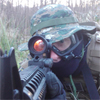The P/N is the NSN, or National Stock Number. The first 4 are the FSC (Federal Supply Code). Of the FSC, the first 2 digits identify the category, and the next 2 identify the class within the category. The next two digits identify the country of origin (00 and 01 show US made products). The next three identify the manufacturer, and the last 4 are the part number. Although it is more like the last 7 identify the manufacturer and part number together. Different sizes from the same manufacturer generally have the same 3 digit identifier and different last 4s. Manufacturers who make a metric ton of different parts, or have been in business since Christ was a Corporal may have multiple 3-digit identifiers as well. Not sure if vendors can share one identifier across a couple of vendors.
Oh, and just to get confusing, the identifier is based on the first brand contracted. For example, acetaminophen, which is bought from a bunch of different manufacturers, it's ordered based on one NSN, and whatever brand is cheapest is what you get. The NSN may be for the Tylenol brand, but you get what you get.
The nomenclature box has the descriptor that you can use to order the set through unit supply channels. It's fairly important to make sure the nomenclature matches the NSN, or it's dealer's choice if you get tthe thing you ordered by NSN, or the nomenclature item. Usually which ever one you didn't actually want / need. I.e., if you put in the descriptor for aspirin but the NSN for band-aids, you might get one or the other, or your order might get cancelled with no notice or warning, and there is no way to predict the outcome, and attempting to observe the decision process may change the outcome. Schroedinger's Bandages.
tl;dr: It's basically a pick ticket for inventory management.
Your Latest Acquisition Part 3
20$ for:
Matrix/JG SVD
3 Metal AK Hi-Caps
Smart charger and 2 standard chargers
3 batteries

I mostly needed the smart charger but hey, why just buy a charger when you can get all that other stuff for the same price?
Matrix/JG SVD
3 Metal AK Hi-Caps
Smart charger and 2 standard chargers
3 batteries

I mostly needed the smart charger but hey, why just buy a charger when you can get all that other stuff for the same price?
-

Blackbriar - Soldier

- Team: N/A
- Posts: 220
- Age: 31
- Images: 1
- Joined: Sun Jul 26, 2009 11:21 pm
- Location: Salem
Order_66 wrote:Nasty, where did you score those patches?
You can search those Star Wars patches on Ebay.
You Fancy Huh?!


-

Regular Guy - Soldier

- Team: N/A
- Posts: 352
- Age: 46
- Joined: Tue Aug 17, 2010 4:43 pm
- Location: In your bedroom

LITE 9" rail in Dark Earth with Daniel Defense trades, OD face wrap, birdcage flash hider, and a cheap duffel to put guns and stuff in.

The floor after an attempt at removing the standard barrel nut without a barrel nut wrench. I really wanted to put that rail on today. Maybe I'll keep trying....

Success! But at what cost? There's no going back now.



Woo! Trades! People like trades right?
I'm a "fair weather" airsofter. I only play in the pouring rain, freezing cold, or broiling heat.
-

Mr. Technicality - Soldier

- Team: N/A
- Posts: 303
- Age: 32
- Images: 1
- Joined: Fri Apr 30, 2010 1:52 am
- Location: Seattle, WA
Got me a LBT 6094 replica, Condor double AR mag pouch, and Condor T&T admin pouch. I have to say, for a smaller person, this is the most comfortable vest I've ever worn. Also, very well made for the Chicom stuff.


"Where are you going?"
"I am leaving.....you are about to explode." -Teal'c
"I am leaving.....you are about to explode." -Teal'c
-

vibora - Soldier

- Team: N/A
- Posts: 155
- Age: 32
- Images: 7
- Joined: Mon Jun 29, 2009 8:29 am
- Location: Prescott, AZ
Group picture, browning knife at the bottom:

TT Utility pouch (using as a hydro)

G&P WOC with an Inokatsu barrel, RIS, front sight, etc, and chrome RAtech steel bolt with a 5ku NPAS and a ProWin V2 mag (spare bolt is a G&P with an AGM nozzle)


Oakley SI assault gloves in XL (FOR SALE or trade for smaller size)



TT Utility pouch (using as a hydro)

G&P WOC with an Inokatsu barrel, RIS, front sight, etc, and chrome RAtech steel bolt with a 5ku NPAS and a ProWin V2 mag (spare bolt is a G&P with an AGM nozzle)


Oakley SI assault gloves in XL (FOR SALE or trade for smaller size)


-

league 4 - Specops

- Team: 9/G
- Posts: 1980
- Age: 32
- Images: 1
- Joined: Sun Aug 05, 2007 7:27 pm
- Location: Fort Knox
Nasty wrote:Should've got it in khaki, so you could make a SEAL/AFSOC kit
It is Khaki, or whatever MJK is. You just can't tell from the pictures; the lighting in my basement is horrible. The SEAL/AFSOC kit was the end goal here. This will also be worn over ABUs for all of my AFROTC tac exercises.
"Where are you going?"
"I am leaving.....you are about to explode." -Teal'c
"I am leaving.....you are about to explode." -Teal'c
-

vibora - Soldier

- Team: N/A
- Posts: 155
- Age: 32
- Images: 7
- Joined: Mon Jun 29, 2009 8:29 am
- Location: Prescott, AZ
Incoming 200's should be getting ABUs sometime this coming semester, and it is likely that we will be restricted to that. However, if I'm made a proctor, I can wear pretty much whatever the hell I want. Last semester, they made all of our freshmen (including me) wear PTUs to all outdoor exercises. This is me at our big "end-of-year" FTX: http://airsoftpacific.com/album_showpag ... ic_id=5264 I'd like to think that I'm the first person to gearwhore out the Air Force PT uniform. 

"Where are you going?"
"I am leaving.....you are about to explode." -Teal'c
"I am leaving.....you are about to explode." -Teal'c
-

vibora - Soldier

- Team: N/A
- Posts: 155
- Age: 32
- Images: 7
- Joined: Mon Jun 29, 2009 8:29 am
- Location: Prescott, AZ
Things I've purchased in the last month (everything is in new condition):
Asolo Morans:

Patagonia Level 5 PCU set:

And lastly, a AI MBSS in CB, and a EI M4 pouch in CB:

I'm selling the PCU pants, because they are a size medium-regular and are a tad bit small. If anyone is interested in them, or in doing a trade for a large-regular let me know by PM.
Asolo Morans:

Patagonia Level 5 PCU set:

And lastly, a AI MBSS in CB, and a EI M4 pouch in CB:

I'm selling the PCU pants, because they are a size medium-regular and are a tad bit small. If anyone is interested in them, or in doing a trade for a large-regular let me know by PM.
- chilicon
- Grunt

- Team: N/A
- Posts: 70
- Age: 31
- Images: 1
- Joined: Thu Sep 23, 2010 4:12 pm
- Location: Issaquah, WA
Return to Community General Discussion
Who is online
Users browsing this forum: No registered users and 2 guests











